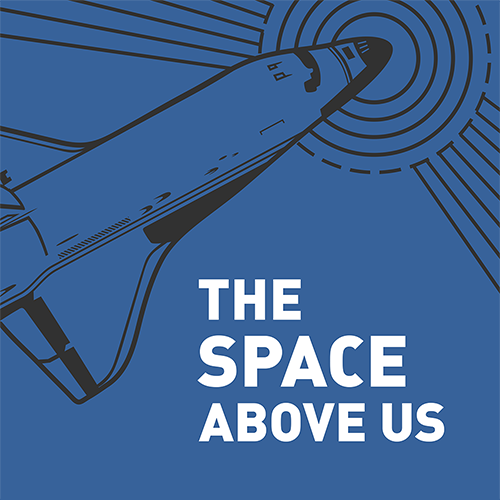Episode 142: STS-67 - A Little More of the Ol' Ultraviolet (ASTRO-2)
Table of Contents
ASTRO-1 was a huge success, shining new light (more or less literally) on the universe with its ultraviolet observatory. But that was almost 30 flights ago. It’s time for the new and improved ASTRO-2 to see what’s out there. We’ll also answer that question I’m sure everyone was wondering: which moon is ugliest?
Episode Audio #
Photos #
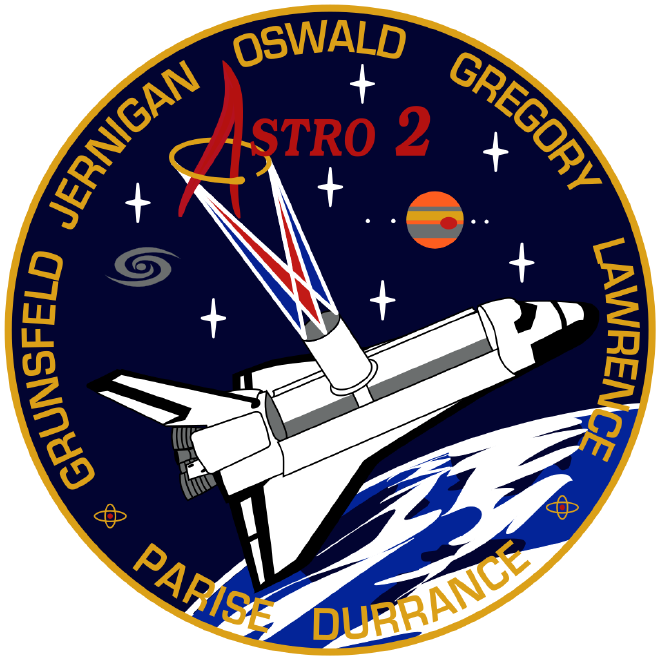
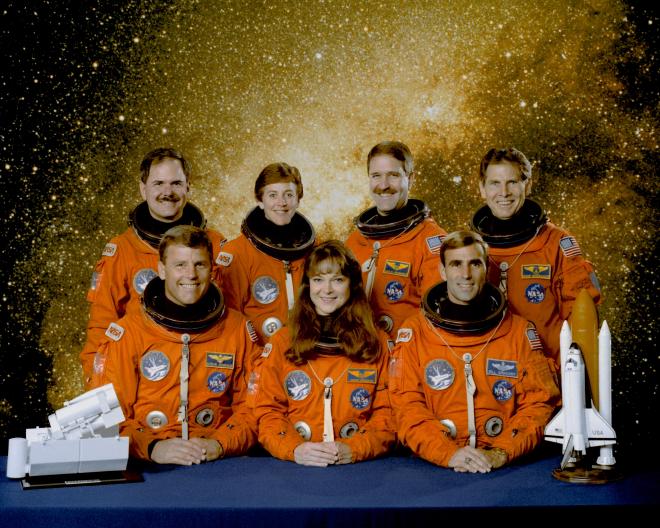
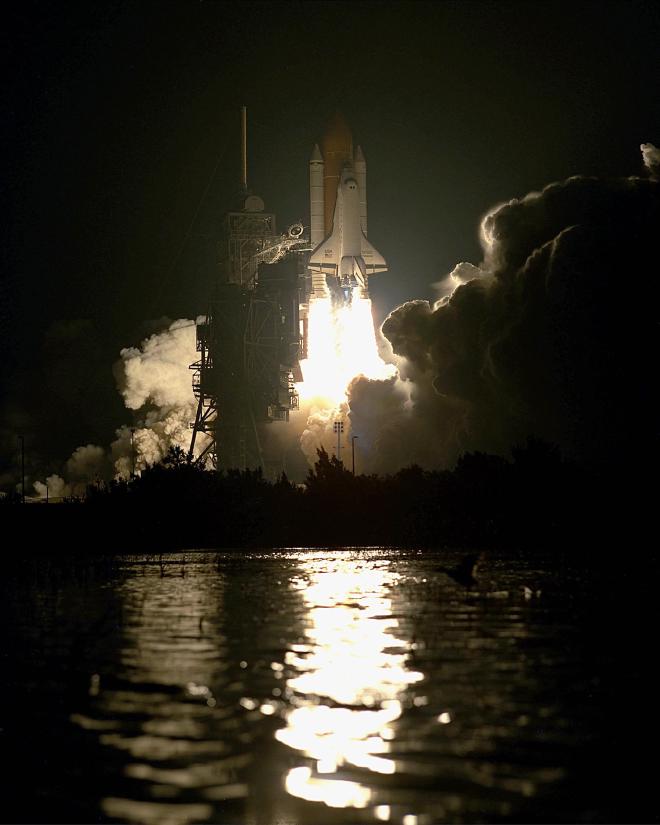
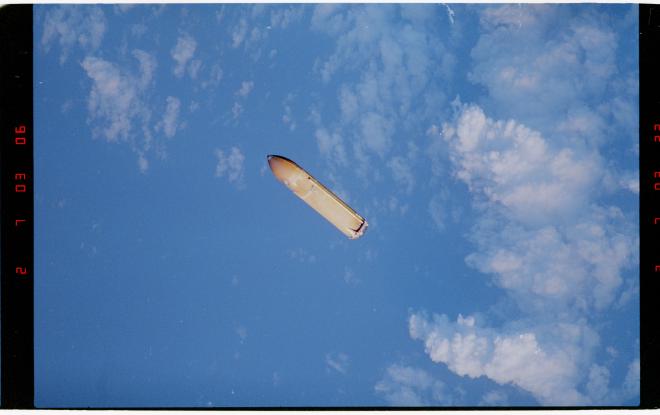
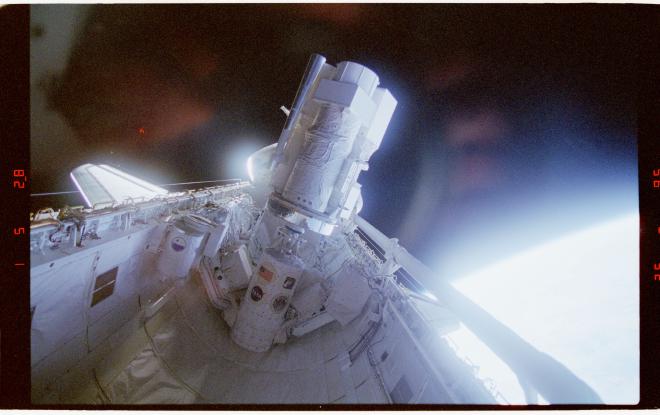
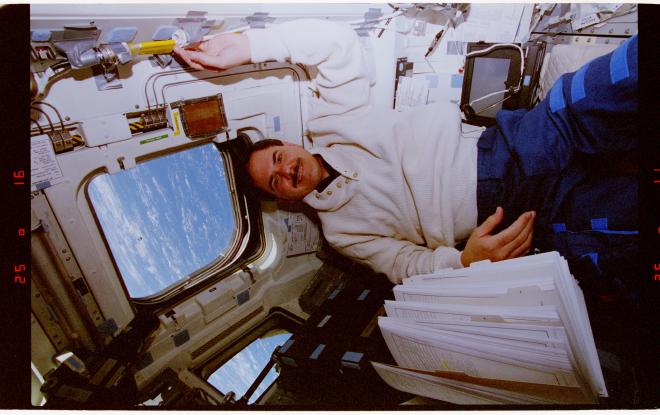
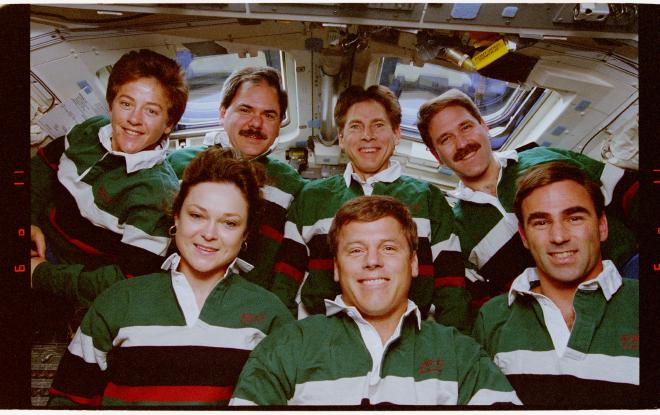
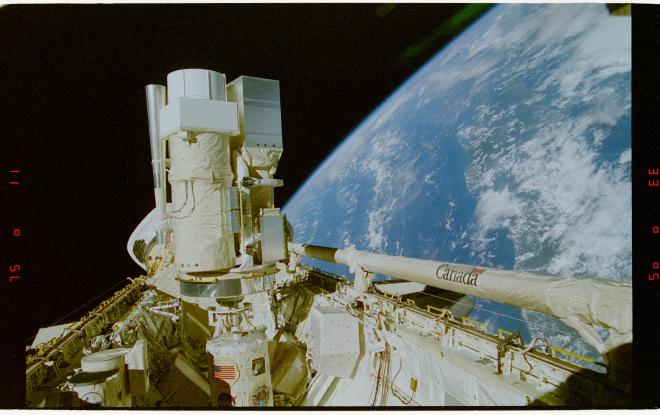
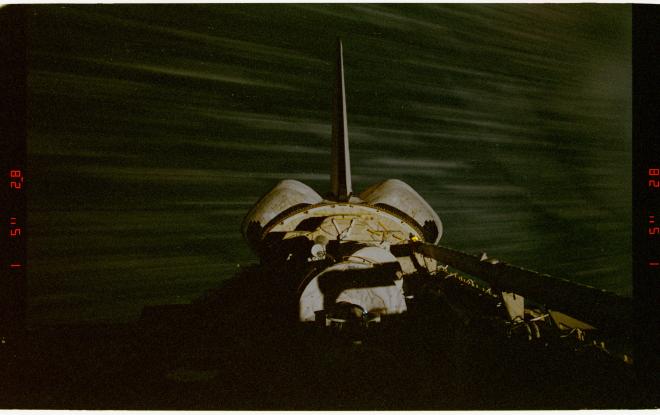
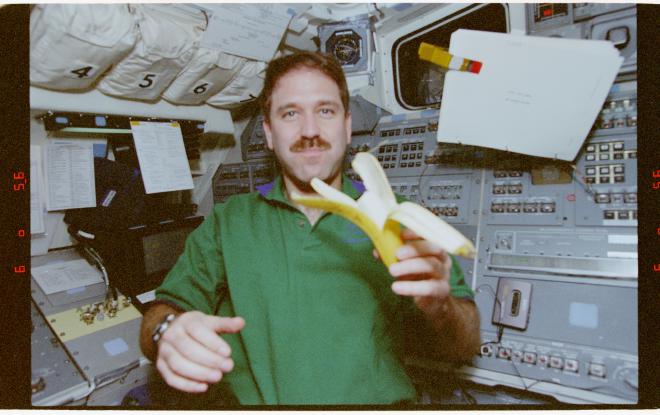
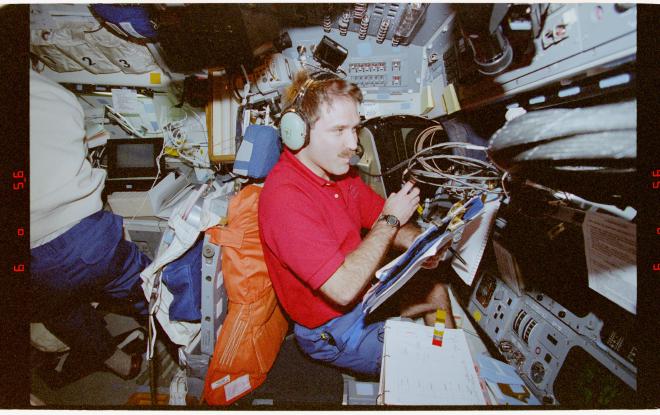
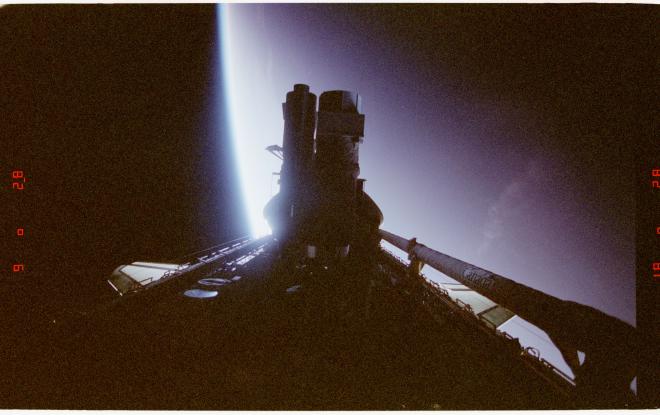
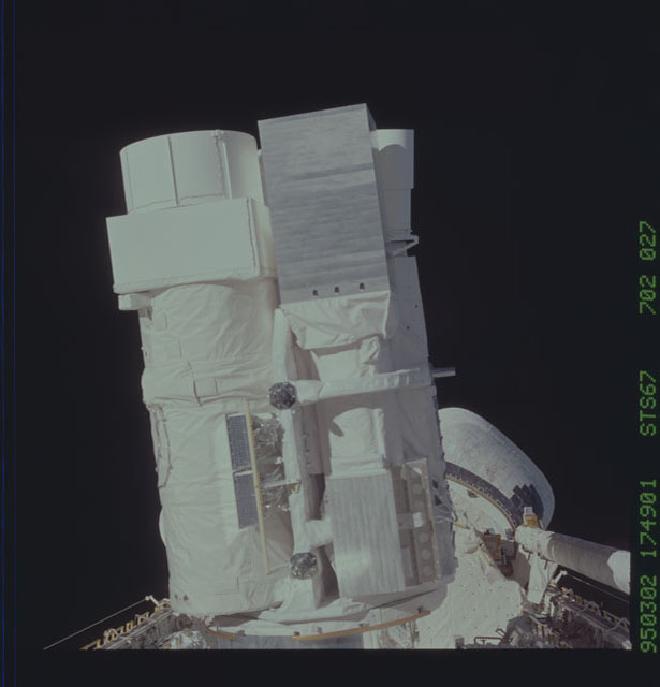
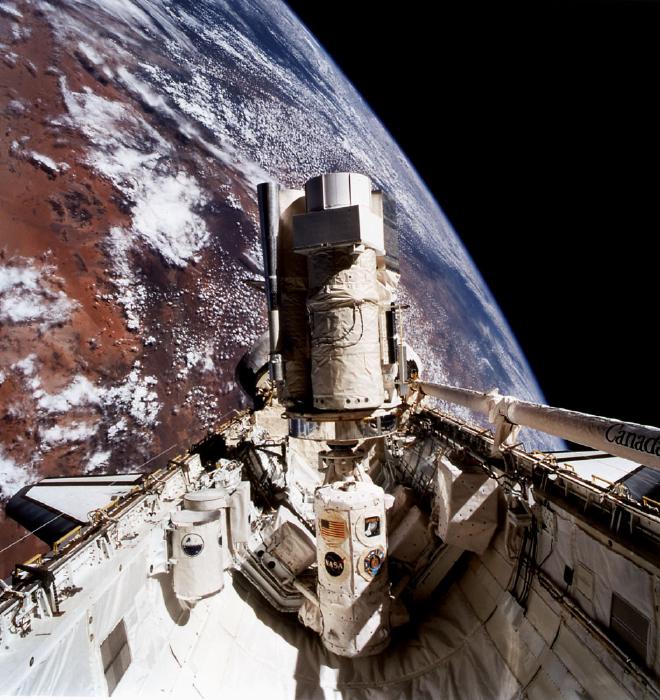
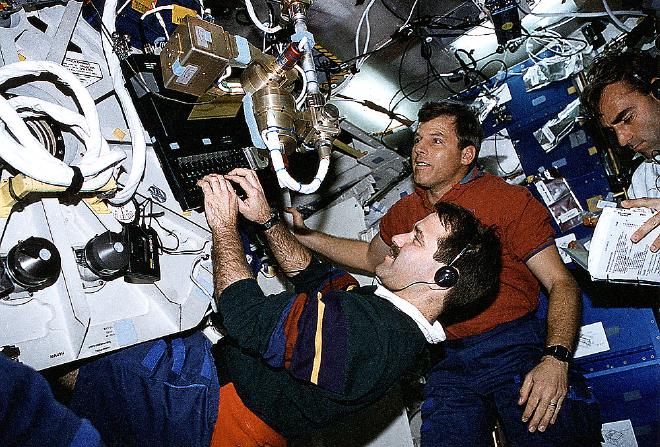
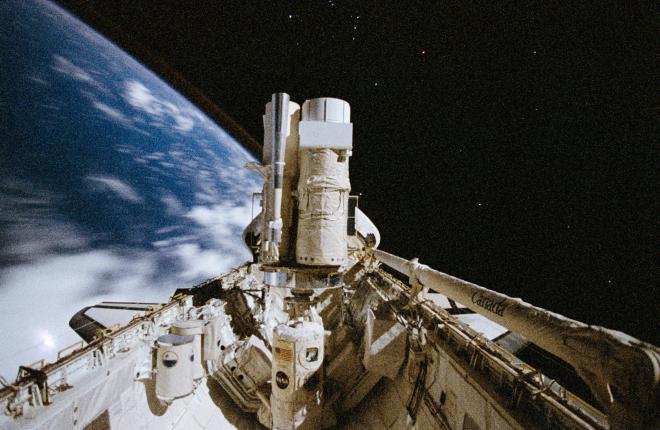
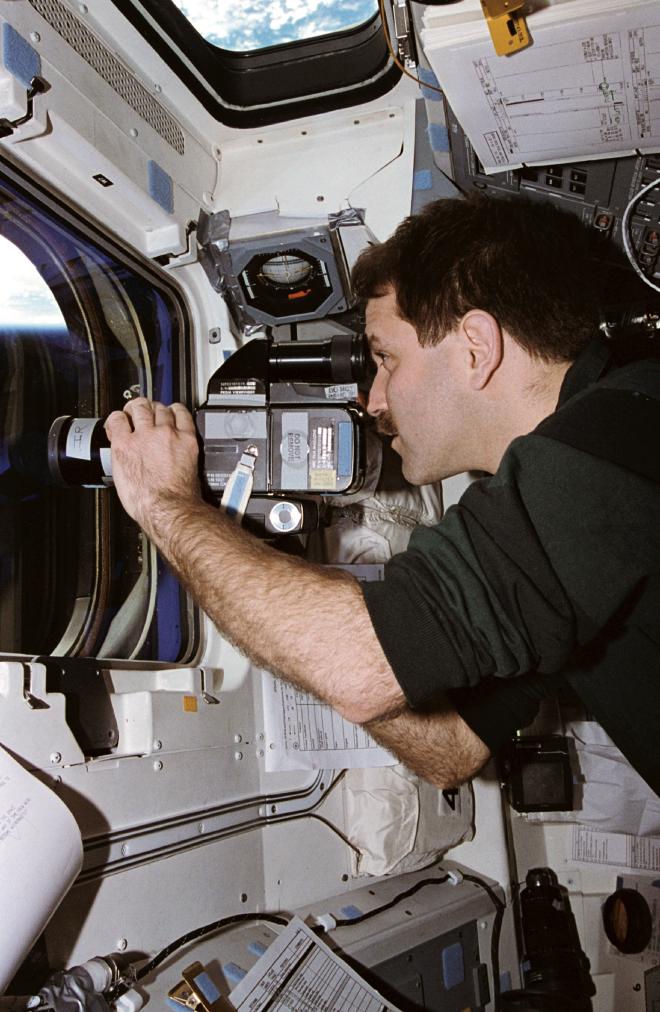
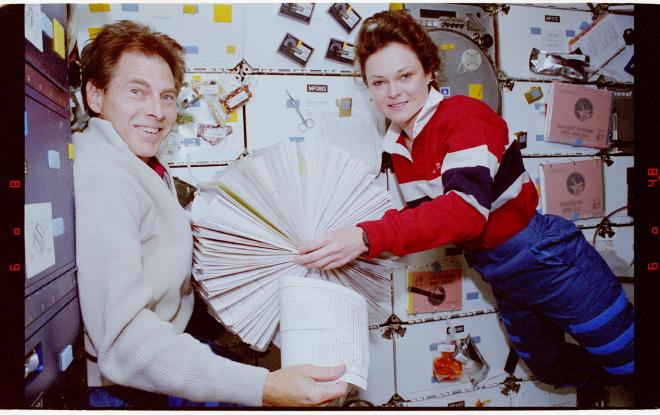
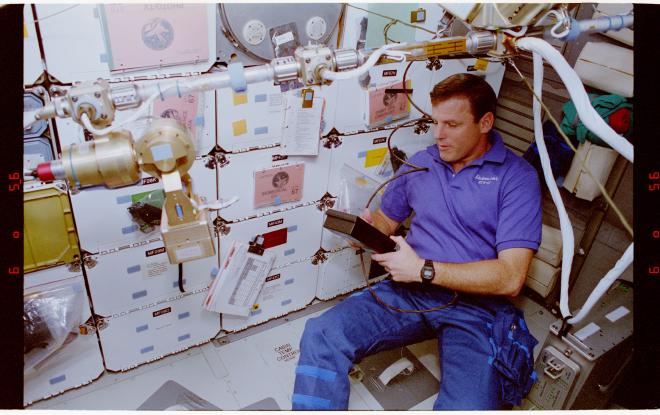
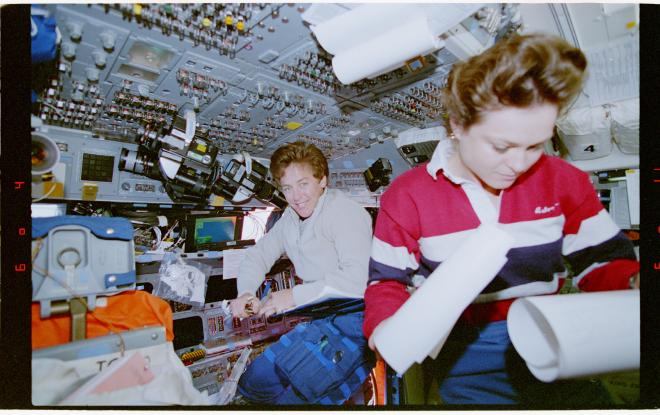
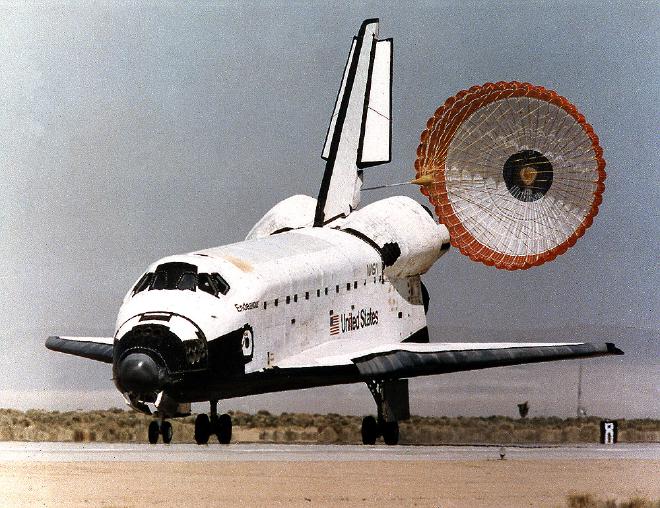
For more photos, head over to our friends at Wikiarchives.space: https://wikiarchives.space/index.php?/category/863
Post-Flight Presentation #
If you’d like to see the mission in motion you can check out the post-flight presentation here:
Mission Highlights Resource Tape #
Ever wanted to watch almost an hour of B-roll from STS-67? Well now’s your chance!
Intergalactic Helium Paper #
Thanks to listener Daniel Solis for sending me this paper about the intergalactic helium research mentioned in the episode: https://arxiv.org/abs/1810.06561
Transcript #
NOTE: This transcript was made by me just copying and pasting the script that I read to make the podcast. I often tweak the phrasing on the fly and then forget to update the script, so this is not guaranteed to align perfectly with the episode audio, but it should be pretty close. Also, since these are really only intended to be read by myself, I might use some funky punctuation to help remind myself how I want a sentence to flow, so don’t look to these as a grammar reference. If you notice any egregious transcription errors or notes to myself that I neglected to remove, feel free to let me know and I’ll fix it.
Hello, and welcome to The Space Above Us. Episode 142, Space Shuttle Flight 68, STS-67: A little more of the old ultraviolet
Last time, we channeled our inner Tom Stafford, and brought Space Shuttle Discovery as close to docking with the Russian space station Mir as it was possible to get without actually doing it. The US and Russia weren’t quite ready to cross those final ten meters just yet, but we’re getting really close. The flight also provided a convenient technical problem in the form of a thruster leak. It wasn’t mission-threatening but it also wasn’t trivial, serving as a great tutorial level for the two space agencies which have gotten a little rusty with working together.
Today’s story will be focusing less on meters, and more on light-years. Because today, we’re talking about ASTRO-2. If you’re having trouble remembering ASTRO-1 off the top of your head, you can perhaps be forgiven, since it flew on STS-35, thirty missions ago. If nothing else, the ASTRO payload would be notable since in a rarity for NASA experiments, it is not some tortured acronym like.. I don’t know.. Awesome Space Telescope Ready for Orbit. It’s just “astro”. But actually, there are plenty other reasons why ASTRO-1 was notable. It was a groundbreaking experiment in the area of ultraviolet astronomy. Ultraviolet, of course, is a form of light that has a shorter wavelength than the visible light we all know and love. As the name would imply, it’s the light you get if you go from green to blue to indigo to violet.. and just keep going. The human eye can’t see the light anymore, but it’s still there. UV light is perhaps best known as the source of psychedelic posters and nasty sunburns, but it’s also a super useful tool for astronomers. UV light is generated by high energy events and can provide valuable clues into how stars are born and die, the nature of the early universe, and countless other things.
The trouble is.. most UV light is blocked by the Earth’s atmosphere. This is great for you, me, and any other non-plant creature that enjoys staying alive, but it’s a bummer if you’re an astronomer who wants to collect that light to learn about the universe. It is for this reason that other than a precious few minutes above the atmosphere on suborbital sounding rockets, ASTRO-1 was the first opportunity for the scientific community to really see what was going on in space, in the ultraviolet spectrum. Which is pretty wild when you consider that it didn’t fly until December of 1990. Just another reminder that we’re still continuing to learn and discover new things about the universe all the time.
ASTRO-1 was a huge win for astronomers, but the mission could have gone better. Plagued by technical problems, the crew and ground had to scramble to come up with clever workarounds and salvage what they could from the mission. For example, by the fifth day of the mission, both of the devices used to enter and display data for the payload computer had failed. They had apparently overheated after their vents were clogged with lint. Yet another way that spaceflight will not tolerate carelessness, incapacity, and neglect. Bet you didn’t think that “lint” would be on the list of stuff that could get you! Thankfully for everyone, STS-35 carried several professional astronomers, and with a lot of interaction with the ground and some manual pointing of instruments, most of the missions’ goals were able to be completed successfully. The unique data provided by these ultraviolet instruments only further increased the astronomy community’s appetite for more, so here we are again, flying ASTRO-2.
In order to gather as much data as possible and take advantage of their brief time on orbit, for STS-67 that brief time was going to be a little less brief than normal. Space Shuttle Endeavour would be carrying the Extended Duration Orbit pallet at the back of its payload bay, containing several tons of additional hydrogen and oxygen. These gases provided additional reactants to Endeavour’s fuel cells, which provided more electricity, which provided more time on orbit. In fact, we’re going to go for the record. Since we’ll have so much time on orbit to peer out into the payload bay, let’s hold off on a detailed rundown of the ASTRO instruments until after MECO. But first, let’s meet the crew.
Commanding the mission was Steve Oswald, who we last saw flying as pilot on STS-56. Maybe Oswald just likes flying payloads that start with “A” and end in “2” since on that flight he helped usher ATLAS-2 safely into orbit and back, and this time he’ll be doing the same with ASTRO-2. Well, I guess we’ll never know, because while he’ll stick around as a manager, this is his third and final flight.
Joining Oz up front would be today’s pilot, Bill Gregory. William Gregory was born on May 14th, 1957 in Lockport, New York. Gregory attended the US Air Force Academy before picking up Master’s degrees in Engineering from Columbia University and Management from Troy State. For five years he was an operational fighter pilot, soaring through the skies in an F-111 before moving on to the US Air Force Test Pilot School. As a test pilot at Edwards he flew the F-4, A-7D, and F-15, with over 40 different types of aircraft eventually finding their way into his flight log over the course of his career. After all that, it’s no surprise that in 1990 he was selected as an astronaut. I’ve seen several sources note that he goes by the nickname “Borneo” but didn’t see why that was his nickname, so I guess it’ll just be a fun mystery. Especially because just as we’re getting to know Borneo, he’s heading off, since this is his first and only flight.
Someone who will be sticking around a little longer can be found sitting directly behind Gregory, Mission Specialist 1, John Grunsfeld. John Grunsfeld was born in Chicago, Illinois, which means he’s probably one of the few people to move to the Boston area and think the winters aren’t so cold. That’s because Grunsfeld headed east to attend the Massachusetts Institute of Technology, earning a Bachelor’s degree in Physics. He then headed back to Chicago, picking up a Master’s and then a PhD in Physics from the University of Chicago. Grunsfeld studied to become an astronomer and become an astronomer he did. Among other things he spent a year at the University of Tokyo as a visiting scientist, studied x-ray and gamma ray astronomy, and probed binary pulsars using a variety of satellites and telescopes. Grunsfeld was selected as an astronaut in 1992 and this is his first of five flights, including three to the Hubble Space Telescope. Fun fact, Grunsfeld is the only person to have seen the Hubble up close in space three times.
Sitting in the center seat was Mission Specialist 2, Wendy Lawrence. Wendy Lawrence was born on July 2nd, 1959 in Jacksonville, Florida. She attended the US Naval Academy, picking up a Bachelor’s degree in ocean engineering, and a little later down the road would earn a Master’s in the same subject from MIT. In-between she became a naval aviator, specializing in helicopters. Over the course of her career she logged over 1,500 hours flying six different types of helicopters, including more than 800 landings on ships. After nine years of that, she returned to the US Naval Academy as a physics instructor. She was selected as an astronaut in 1992, and this is her first of four flights. Oh, and 21 years after this mission, she had her picture taken with some space nerd who only three weeks earlier had started a spaceflight history podcast.
Moving downstairs, we find Mission Specialist 3, and our second astronomer on this flight, Tammy Jernigan. When we last saw Jernigan she was flying on Space Shuttle Columbia for STS-52, which, among other things, deployed the LAGEOS-II payload. This is her third of five flights.
Believe it or not we’ve still got two astronomers to go, in the form of our two payload specialists. Payload Specialist 1 was Sam Durrance, who we know from STS-35, which makes sense since that flew the ASTRO-1 mission. This is Durrance’s second and final flight.
And last, but certainly not least, and perhaps not a surprise, was Payload Specialist 2, Ron Parise. When we last saw Parise he was flying alongside his Payload Specialist colleague, Sam Durrance, on STS-35. And just like Durrance this is his second and final flight.
Having Durrance and Parise along on STS-35 was especially helpful since they were not only astronomers, but were intimately involved with the telescopes that make up the ASTRO package. So when technical snags cropped up, they were able to help salvage the mission. Thankfully, things will go a little smoother this time.
When the scheduled launch day arrived, the weather was looking pretty iffy, as Florida weather is wont to do, with only around a 20 to 40 percent chance of favorable conditions. In fact, later the commander commented that the crew sort of considered it a dress rehearsal since their chances were so slim. But twenty percent’s not nothing, so the decision was made to proceed with the countdown anyway and hope for the best. The launch was scheduled for the middle of the night, which was unusual for a non-rendezvous mission. But just because the shuttle wasn’t rendezvousing with another spacecraft didn’t meant it didn’t have orbit requirements. In this case, the goal was to ensure that Endeavour passed through the South Atlantic Anomaly during orbital daytime. Wait.. what. OK, one quick step back.
Way back on NASA’s first ever uncrewed orbital flight, a belt of radiation was discovered around the Earth. The planet’s magnetic field was trapping charged particles from the sun and accelerating them to crazy speeds. These belts of radiation were dubbed the van Allen belts after James van Allen, the scientist responsible for the instrument that discovered them. There are two main belts, one closer to the Earth, and one a little further away, and they can be troublesome to space missions. If your spacecraft contains fragile little humans who have somehow found themselves in this unlikely environment, they can rapidly impart unhealthy amounts of radiation. In fact, this is often brought up by doofuses who don’t believe humans have been to the moon. They point out that flying through the van Allen belts would be too dangerous to the crews, apparently neglecting to notice that the Apollo crews actually flew pretty darn fast so weren’t in the belts for very long. But they’re right that you don’t want to hang out in the van Allen belts if you can help it. We actually encountered this when the high-flying Gemini XI brushed up against them.
But even if you’re talking about an uncrewed mission, the van Allen belts can be trouble. The high radiation can mess with electronics, confusing or outright breaking the onboard computers. Luckily, the inner belt doesn’t start until around 1000 kilometers in altitude, so low orbit missions have plenty of room to play. Why am I telling you all this? Because while in general the van Allen belts are up pretty high, there’s one location where they dip down low, a location we call the South Atlantic Anomaly. When spacecraft fly through this region, roughly off the coast of Brazil, operators can expect to encounter more computer issues than usual. To give you an idea of how impactful this can be, one of the requirements on the mission I work on for my day job, OSAM-1, is that capture of Landsat 7 can’t happen in the South Atlantic Anomaly. The chances are too high for a computer to flip into safe mode or some other nasty surprise that would interrupt the rendezvous.
So in this case, since ASTRO-2 would be carrying a bunch of sensitive imaging equipment and photographic film, the decision was made to ensure that passes through the South Atlantic Anomaly happened in daylight, when less sensitive observations were being done anyway.
That was a pretty long-winded way of saying “they launched in the middle of the night to avoid making sensitive observations while flying through the SAA” but I think it’s cool how restrictions like this can propagate through the mission design and lead to something like a middle of the night launch.
As the countdown approached zero, everything proceeded smoothly, including the weather. Other than a minor fuel cell degradation issue caused by some residual helium in the lines to the Extended Duration Orbiter, and a problem with a heater on the Flash Evaporator System, everything worked great. So with only a 73 second delay, on March 2nd, 1995 at 1:38 AM, Space Shuttle Endeavour lit up the Florida sky, and STS-67 was underway.
If you were to somehow find yourself in March of 1995, first I’d advise you buy some Apple stock, but also, if you wanted to follow the day by day twists and turns of the mission, you’d have a new option at your disposal. For the first time, NASA was providing live coverage of a space shuttle mission on this newfangled thing called a website. It’s kind of funny seeing what we consider to be pretty basic stuff treated as such a foreign concept.. one source wrote “Computer users could follow the progress of the mission on the STS-67 quote-unquote “home page” on the World Wide Web”. I actually tried to find this website by using Archive.org’s invaluable tool the Wayback Machine, but the page was so old it actually predated Archive.org, which is pretty wild. But don’t worry, time traveler, if you miss it, you’ll have another chance, since quote “Individuals at Marshall Space Flight Center who initiated the experiment plan to repeat the on-line experience for an upcoming Spacelab flight this fall.” Yes, this experiment of having a website. Just be sure to keep your copy of Netscape Navigator up to date..
The ride to orbit was uneventful and the payload bay doors were soon open as the crew scrambled out of their pressure suits and began to calibrate the instruments, but there was a minor hiccup. A thruster leak. Now, I didn’t expect to be talking so much about reaction control thrusters for two episodes in a row, but I thought this was pretty interesting, especially now that we know a little more about them.
Shortly into the mission, the temperature of the oxidizer-injector on thruster L5D reported it was too cold, a strong indicator of a leak. Thanks to the previous episode, we can identify thruster L5D as being on the left OMS pod, pointing down. And since it’s on fuel manifold 5, it’s one of the small vernier jets. The thruster was shut down and the primary jets took over while the crew and mission control investigated. It turns out that this hiccup was anticipated. The last time Endeavour flew, on STS-68, they saw the same problem, but it turned out there wasn’t actually a leak, it was just some wonky instrumentation. So before long, a pre-approved computer tweak was uplinked to Endeavour, slightly changing the tolerances on the oxidizer injector temperature in order to prevent the false positive.
The reason I found this interesting was it’s a great example of how the space shuttle’s redundancy helped maintain not just safety, but also mission operations. The ground crews could have removed and replaced the thruster after STS-68, but they weren’t even planning on taking the left OMS pod off, let alone digging around in the plumbing. It would’ve cost a bunch of time and money. Instead, they looked at the situation. What if the sensor misbehaved again? Well, if it was a small false positive like last time they could just tweak the limits. OK but what if it exceeded the new limits with a stronger false positive? They could fall back on the temperature of the fuel injector for the same thruster. OK but what if the thruster actually failed? Well, they’d lose a downward facing vernier jet on the left side, but there were three primary thrusters that could also do the job. So despite the issue, it was fine to fly with the thruster as-is. This kind of call is obviously a difficult one to make, and we’ve seen the decision to fly “as-is” and rely on backup systems lead to failure and heartbreak before. But to me, something like this is a sign of a healthy operational program, and is pretty cool.
Not to be left out, around 12 hours into the mission, the R4R thruster started leaking, which required the crew to close the covers on the ASTRO instruments for an hour, but since they were still calibrating there was no great loss.
OK! So we’re in orbit, the instruments are calibrated, the thrusters have settled down, and it was time to start collecting observations. We’ve got more than two weeks to get as much science as possible done, which is good because we’ve got over 600 celestial objects we’re hoping to examine. Let’s do a quick tour of the instruments.
To visualize this, imagine a cluster of big metal cylinders, each about a meter wide and about four meters long, along with a few thinner cylinders and some weird boxes and wires and stuff. All of this was mounted on what looks like a fancy tripod but what we recognize as the Instrument Pointing System, which we first saw fly on STS-51F, and which we’re actually seeing for the third and final time right now. The Instrument Pointing System, or IPS, does what it says on the box, and allows the crew to point the instrument cluster at whatever astronomical object they’re studying. It was necessary since while the orbiter itself is capable of pretty tight attitude control, the IPS was able to build on that and provide a rock solid foundation for these instruments.
First, let’s look at the Hopkins Ultraviolet Telescope, or HUT. Sporting some fancy improvements that increased its sensitivity three fold from last time, the Hopkins Ultraviolet Telescope would be doing a few things, but its primary goal was to look for intergalactic helium, which isn’t just a great potential band name. The thought was that as part of the birth of the universe, shortly after the big bang, some helium was created and was spread all around and might just be hanging out in the vast spaces between galaxies. So finding this helium would help refine our understanding of the early universe. But you can’t just see helium, so scientists were going to have to get a little clever. Instead of looking for the helium directly, they were going to use HUT to look at certain quasars, high energy objects that put out a lot of high energy light. This light would have traveled for billions of light years, across the intergalactic void. And if along the way it encountered any helium, the light would have been subtly changed. By analyzing the wavelengths of light received and creating a spectrogram, scientists were able to detect those changes and infer the presence of helium, if it was there. The same spectral analysis could be used to determine what elements are present in objects, from billions of light-years away, just by their light alone. If you’re waiting for me to tell you if they found helium or not, this is the part where I remind you that these scientific studies typically don’t come out for a few years, and usually aren’t in my giant pile of NASA documents so I don’t actually know. So I’ll just move on before drawing even more attention to that anti-climactic conclusion.
Alongside the Hopkins Ultraviolet Telescope was the Wisconsin Ultraviolet Photo-Polarimeter Experiment, which has the delightful acronym “WUPPE”. WUPPE would also be using spectrometry to analyze distant objects but it could also take advantage of another property of light: its polarization. Light is made up of two parts: an electric field and a magnetic field, with both fields perpendicular to each other. The fields continuously cancel each other out and build themselves back up, propagating through space, and that’s how light moves. Since the fields are always perpendicular to each other, they have a defined orientation. Let’s say you’re looking right at the beam of light as it arrives. Is the electric field horizontal and the magnetic field vertical? Or maybe the electric field is vertical and the magnetic field is horizontal. Or maybe they’re both tilted part way. What we’re describing is the polarization of the light. Typically, light comes in just a random assortment of polarizations, all over the place. But certain interactions can cause that polarization to become less random, and orient the photons to the same polarization. So by carefully measuring the polarization of light from distant objects, we can learn about stuff we can’t see, such as magnetic fields and interstellar dust. So suddenly we can detect super powerful magnetic fields around rapidly spinning dead stars, or judge the density of dust clouds between the stars. It’s pretty slick.
Maybe this is obvious, but I love how scientists can take something like the orientation of light waves, think about it for a while, perform some measurements, and then be able to tell us “oh, that thing all the way across the galaxy? Yeah, here’s how strong its magnetic field is”, it’s amazing.
And the last instrument we’ll discuss today is the Ultraviolet Imaging Telescope. This telescope would be taking photos that each big enough include enough of the sky that the moon would fit nicely in the center without too much extra space around it. That’s actually pretty wide for a telescope, which typically focus in on a smaller angular area. For example, WF/PC, the Hubble Space Telescope’s Wide Field/Planetary Camera covered an area 250 times smaller. But The Ultraviolet Imaging Telescope wouldn’t just be taking big photos, it’d also be taking long photos, with exposures lasting up to 30 minutes. By taking such long exposures on sensitive film, it was possible to observe stars that are 100 million times fainter than the faintest star you can see on earth with the naked eye. But jeez, a 30 minute exposure? If there’s one thing we’ve learned with all these self-analysis experiments that look at the environment on and around the orbiter, it’s that the orbiter is a pretty noisy vehicle. You’ve got thrusters firing, crew members bouncing around, fuel cells churning, the waste collection system flushing.. it’s a lot of stuff that can disturb a 30 minute long photo.
So in addition to the already super-stable Instrument Pointing System, the Ultraviolet Imaging Telescope took advantage of a clever mechanism that utilized accelerometers and computer-controlled mirrors to make a hyper-stable platform for long exposure photography. Once they got back to earth, the film would be developed and scanned into images that were 2,048 pixels on each side.. and we’re still far enough back in the 1990s that the NASA press kit felt the need to explain what pixels are.
Throughout the lengthy flight, the schedule was broken up into blocks that were two revolutions long, just over three hours. During that time, one instrument would take priority on one target. Typically the other instruments would also look at the same thing, putting their particular strengths to use, but it was also possible to study nearby celestial objects. As you might expect from a flight like this, the crew were broken up into two shifts, with the red shift consisting of Commander Steve Oswald, Pilot Bill Gregory, Mission Specialist John Grunsfeld and Payload Specialist Ron Parise. The blue shift was lead by Mission Specialists Tammy Jernigan and Wendy Lawrence along with Payload Specialist Sam Durrance, with Jernigan serving as overall payload commander. Each shift had a mission specialist to help operate the Instrument Pointing System, a Payload Specialist to help run the instruments, and a third crew member to perform any attitude maneuvers required of the orbiter. For the red shift that would be the commander and pilot, and for the blue shift it was mission specialist and flight engineer Wendy Lawrence.
For each observation, the mission specialist and payload specialist would be assisted by a laptop running a program that gave a computer-generated view of the sky, allowing them to easily see where they were pointing. On top of that, they could superimpose the computer images of a star field on top of the actual images coming from the instruments. When the desired star field lined up with the actual image, they knew they were on target.
In fact, thanks to a helpful bulleted list in the May-slash-June 1995 issue of Countdown, I can just read you the whole procedure. This is a little wordy but it’s good to be reminded that when I casually say something like “the crew made an observation using the instruments” it’s actually a whole series of complicated steps. And in fact, these steps from Countdown are themselves glossing over some details. Just a reminder, MS is Mission Specialist, and PS is Payload Specialist. Here we go:
- Crew reviews and, if necessary, modifies prelaunch observation parameters
- MS inputs right ascension and declination (target coordinates) into IPS via DDU
- PS commands instruments to safe configuration for maneuver to target
- Endeavour is maneuvered to observation attitude
- MS moves IPS so that observation target is in HUT and WUPPE fields of view
- PS turns instrument on and identifies star field from star tracker television image
- MS or PS adjusts IPS to place target in the HUT aperture
- PS initiates WUPPE data acquisition and UIT and WFC exposure sequences
- PS or MS monitors IPS-pointing in HUT and WUPPE acquisition cameras
- PS evaluates spectrum of object to verify that it has the expected shape and that there is sufficient exposure time
- Crew reviews the next target in the mission plan
Tammy Jernigan later told the Smithsonian: quote “On STS-67 we got into a rhythm of astronomical observations, and there was a lot of time when the cockpit was darkened. We were running a 24-hour observatory. You would monitor observation of an object for maybe 20 minutes before you had to regroup, repoint the instrument pointing system, and set up the instruments again. So there were whole blocks of time where you could just look out and reflect, talk to the other crew members who were awake on your shift, and really have a sense of what a beautiful universe we inhabit.” unquote
I believe one reason for the three hour schedule blocks was that it made it easier to adjust the schedule on the fly in response to technical issues or to unexpected opportunities. For example, on a few flights we’ve seen a volcano erupt on Earth, providing the crew with a nice science-rich target to point their instruments towards. Well, on flight day 3, the same thing happened, but a little further away from home. NASA’s Infrared Telescope Facility in Hawaii noticed that Io, the closest of Jupiter’s Galilean moons, was erupting. Io is so close to Jupiter that the tidal forces from the planet literally squeeze the planet, flexing it, and prompting frequent volcanic activity. But with ASTRO on orbit, it was a great opportunity to measure it with ultraviolet instrumentation. One source mentioned that the idea here was to measure Io during and after the eruption to see if maybe the frequent volcanic activity contributed to an atmosphere around the moon. Io’s volcanic activity is pretty cool. It’s too bad it looks like dijon mustard that’s been left a plate in the sun for a few weeks. That’s right, I’m calling Io out as the ugliest moon. That’s an official The Space Above Us stance.
Io wasn’t the only unexpected target, either. Only a week before the launch, a binary star system that was thought to be pretty stable suddenly got a thousand times brighter. The thought was that the two-star pair were made up of a typical star and a super dense white dwarf. The sudden increase in brightness could be the white dwarf pulling blobs of gas off of the normal star and eating them up. Another great high-energy event for ASTRO to observe. Plus, the sudden brightness illuminated the whole area around the star more than usual, potentially revealing dust and other stuff that’s normally tricky to see.
The second flight of the ASTRO package of instruments was a huge success for the astronomy community, but it turns out there was one more ultraviolet telescope onboard Endeavour, and its name.. was Endeavour. This is actually just a weird coincidence, but yes, we have the Endeavour telescope flying on the Endeavour orbiter, both named after the same ship used by Captain James Cook to explore the Pacific Ocean. The telescope was actually a pretty big deal in Australia, since it was their biggest space project in something like 20 years. Taking the form of two getaway special canisters, the telescope took up one canister, with data cables leading to a second canister that contained the control equipment. If I’m understanding the mechanism correctly, the telescope was actually sort of two telescopes, one with a wide spectral range and one that was tightly focused on one part of the UV spectrum. By subtracting the wide image from the tight image, a cleaner UV measurement could be obtained. Endeavour could only look where Endeavour was pointed, which is a confusing sentence, but I’m rolling with it. The telescope quietly did its thing in the back of the payload bay throughout the entire mission and was a complete success. So good job, Australia!
Not every experiment on STS-67 was related to astronomy. We have the usual suite of protein crystal experiments and stuff like testing the astronauts’ vision in microgravity. There was also a pretty neat experiment called the Middeck Active Control Experiment, or MACE. This was a weird, gangly-looking experiment that was seeking to investigate control methods for.. well.. weird, gangly-looking things. The question was, if you had a space station with long flexible appendages, could you prevent movement and vibration in one part from disrupting the entire structure? Could you control it without building up a resonance and making the whole thing start flapping around and breaking? That’s what MACE was going to answer.
The apparatus was just under two meters long and was covered in weird little modules containing reaction control wheels and actuators. One set of actuators would impart a specific motion, and another set would try to damp it out, all while floating freely in the middeck. When it was working properly, it sort of looked like it wasn’t doing anything at all. But on the rare occasion that it didn’t work properly, it would start gyrating with more and more intensity, to the amusement of the crew. In fact, one crew member, Commander Oswald, enjoyed the experiment so much that he requested extra time with the apparatus, eventually returning over 50% more data than originally planned. It’s gotta be nice to be an experiment principal investigator and realize that the shuttle mission’s commander has taken a personal interest in your experiment.
On flight day 13, I imagine that the crew were probably starting to get a little tired. Even with two and a half days of free time spread throughout the flight, doing precise work in long shifts, day after day has got to get old eventually. But there was some exciting news to break up the potential monotony. On March 14th, just after midnight Houston time, a Russian Soyuz rocket, carrying a Soyuz spacecraft launched into orbit. On board was the first American to launch on a Russian rocket, Norm Thagard, on his way to a lengthy stay on Mir. With the successful launch, a new record for most humans in space was established, with a total of 13: 7 on Space Shuttle Endeavour, 3 on Mir, and 3 more having just launched.
Two days later, the crew were informed that Thagard and his Russian crewmates had successfully docked with Mir, beginning their multi-month long mission. Later that day, Oswald and Thagard, who had previously flown together on STS-42, briefly chatted over the radio as Endeavour and Mir passed each other. This also marks the first time that NASA astronauts were flying on two different space missions since the Gemini 6 and 7 crews. Pretty cool.
I’m sure you can guess how this next part starts. As the end of the mission wrapped up, the crew safed the instruments and started making preparations to head home.. until the Florida weather said no. So the lengthy mission got one day lengthier. Since the telescopes were already stowed, and the crew had already mostly prepared the cabin the previous day, there was nothing to do but enjoy the view out the window. A perfect way to end a mission. But finally, after cutting their losses and turning their sights on Edwards Air Force Base, Space Shuttle Endeavour performed the deorbit maneuver and soared through an uneventful reentry and touchdown. The flight established a new duration record for the space shuttle, clocking in at 16 days, 15 hours, 8 minutes, and 48 seconds.
STS-67 was a complete success, leaving the researchers who worked on the ASTRO payload ecstatic with the results. ASTRO-1 and ASTRO-2 performed some truly groundbreaking ultraviolet astronomy, and together make up one of the big science success stories for the space shuttle program. They also provide a great example of Payload Specialist program working exactly as intended. Mission specialists and Payload specialists worked side by side and combined their intimate knowledge of the orbiter systems and the scientific equipment to salvage a mission in trouble on ASTRO-1, and to return a wealth of data on ASTRO-2. I think the people who first worked on the early proposals for the shuttle in the early 1970s must have looked at this flight with pride.
Next time.. it’s good that Norm Thagard safely made it to Mir, and it was fun talking to him on the radio, but don’t you think he might be getting a little homesick up there? His Russian colleagues are great but I think he needs a little company from the good ol’ US of A. So how about we go up and visit him. Yeah, that sounds like fun. This next mission will be a real Hoot.
Ad Astra, catch you on the next pass
